
 In 1980, George Lucas and Francis Ford Coppola presented a film by Akira Kurosawa, KAGEMUSHA. It opens with a five minute static shot of three almost identical looking characters sitting in a throne room in their fancy robes, two of them talking about the other one. You got the emperor Shingen there in the middle and his brother is on his right telling him about the guy on his left, how he spotted this petty thief about to be executed and noticed that he looked like the emperor and would make a good double for him. Sure enough he’s a dead ringer. It’s a real good find, this could work out great, right? But the double is kind of belligerent and crazy, and also he very reasonably chafes at the idea of being called a criminal by a guy who has killed thousands in wars and executions.
In 1980, George Lucas and Francis Ford Coppola presented a film by Akira Kurosawa, KAGEMUSHA. It opens with a five minute static shot of three almost identical looking characters sitting in a throne room in their fancy robes, two of them talking about the other one. You got the emperor Shingen there in the middle and his brother is on his right telling him about the guy on his left, how he spotted this petty thief about to be executed and noticed that he looked like the emperor and would make a good double for him. Sure enough he’s a dead ringer. It’s a real good find, this could work out great, right? But the double is kind of belligerent and crazy, and also he very reasonably chafes at the idea of being called a criminal by a guy who has killed thousands in wars and executions.
Maybe with some training though?
I guess people compare KAGEMUSHA to that movie DAVE, where Kevin Klein is a lookalike who has to replace the president, but I haven’t seen that one, so I’ll compare it to FACE/OFF, where a cop pretends to be a criminal? I don’t know. Anyway, the job gets more serious when the emperor gets hit by a sniper and before dying makes his boys promise to keep his death a secret for three years. I didn’t get this at first, but I think it’s because his heir is his grandson, a little boy. Gotta let him grow up to be at least 7 or 8 before tossing him in the deep end.
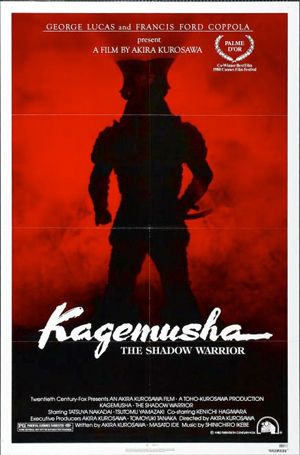 Despite his initial reluctance, the double is inspired by the emperor’s talk. Also he finds his dead body in a big vase and freaks out. He decides to try to do a good job, and undergoes emperor lessons. His reward is a sweet friendship with the kid, at least after getting past the kid’s initial correct feeling that this guy is not his grandpa. Meanwhile, rivals are plotting against them, trying to ambush his palanquin and what not. (I am very surprised that rappers haven’t started traveling in palanquins, by the way.) So there’s alot of maneuvering to make sure nobody finds out that the real emperor is dead.
Despite his initial reluctance, the double is inspired by the emperor’s talk. Also he finds his dead body in a big vase and freaks out. He decides to try to do a good job, and undergoes emperor lessons. His reward is a sweet friendship with the kid, at least after getting past the kid’s initial correct feeling that this guy is not his grandpa. Meanwhile, rivals are plotting against them, trying to ambush his palanquin and what not. (I am very surprised that rappers haven’t started traveling in palanquins, by the way.) So there’s alot of maneuvering to make sure nobody finds out that the real emperor is dead.
The other side has a hunch that he is dead, and they’re trying to prove it so they can make their move. These guys are less entrenched in Japanese tradition, more open to the contributions of other cultures. One guy drinks red wine, which he calls “European sake.” He welcomes a visit from Catholic priests, and even tries getting one who is also a doctor to act as a spy, sending him to the fake emperor on a courtesy call. The double has no choice but to let him come in, because it would be too suspicious to send him away. He fell for the old “traveling Catholic doctor” trick.
There’s not as much humor as you’d think about him being an outsider who doesn’t give a shit pretending to be the emperor. You know Sanjuro would’ve run those uptight handlers through the wringer, this guy is pretty subdued. But at one point he does straight up tell some ladies that he’s not the Emperor, he’s his double, and they take it as a joke, like when Ed Gein told everybody he was digging up graves. That was pretty good.
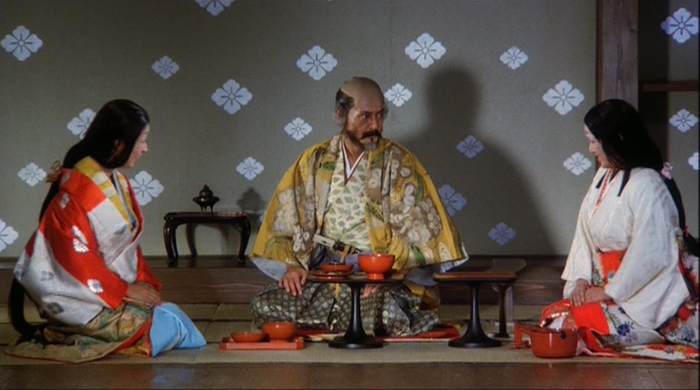
I liked this story but didn’t find it as compelling as most Kurosawa until near the end when the gig is up. When some of the people notice that he doesn’t have the gunshot wound that the real emperor had the cat gets out of the bag. So they thank him for his time, strip off his royal robes and tell him to beat it. When he goes into shock like a loyal career man laid off out of the blue they get in his face until he leaves and then they throw rocks at him. The Sengoku period equivalent of having security escort you out of the building. He just wants to say goodbye to the kid that thinks he’s his grandpa. There’s a really sad scene where it’s much later and he’s outside of the gates with the rest of the peasants, desperately scrambling to get a look at the kid during the funeral.
The look and scale of the movie are incredible – many elaborate, colorful costumes, epic battle scenes with armies on horseback in action, fields of dead and almost-dead soldiers. There’s also a great nightmare sequence filmed on a soundstage with a very stylized painted sky done by Kurosawa himself. (You can really tell that if you look at all the painted storyboards he did. Same style.) As we hear a few times in the movie, “the shadow of a man can never stand up and walk on its own,” and “A shadow cannot exist without a person,” so the double dreams of being haunted by the real emperor, who looks gigantic in his samurai armor.
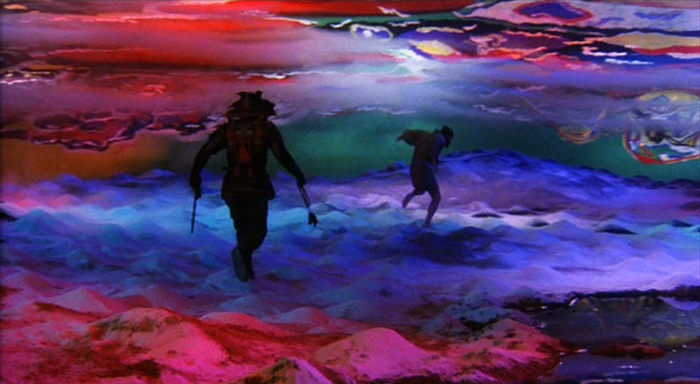
Don’t ever let anybody tell you Kurosawa didn’t do much with color. Or let them tell you, but then laugh at them for saying it.
And then there are all the marching and battling scenes. It’s kind of mind-boggling to consider the difficulty of choreographing and filming these huge mobs of soldiers on horses with armor, spears and banners. It would be hard enough just to maneuver all those people and animals into the right places even if you didn’t have to make sure the camera was set up and moved properly to capture it all. And shit, what about making sure you do it when the sun’s in the right place? Can you imagine somebody doing this now? Of course not. Nobody will ever do this again.
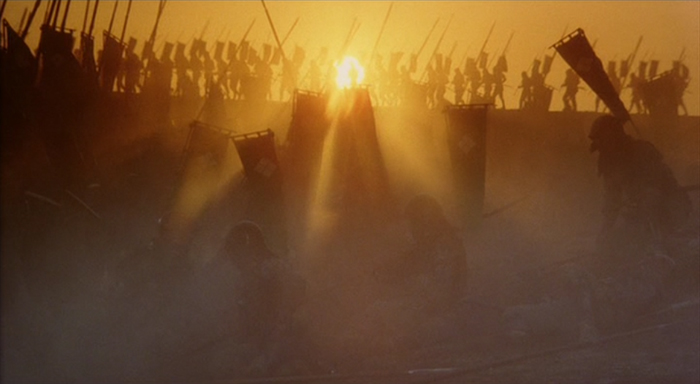
The climax takes on a dreamy feel because the double, now thoroughly invested in what happens to the government he’s been ousted from, hides in tall grass in the middle of it to spy on it all. It’s like Richard Stanley hiding on set as an extra after he got fired from ISLAND OF DR. MOREAU. More than the combat itself, Kurosawa lingers on the aftermath, a field of dead and dying bodies, including many horses on their backs, still jerking and kicking around. I suspect this was not a nice thing to do to the horses on set, but I have no idea how they got them to do it in the first place. Anyway, it’s real upsetting.
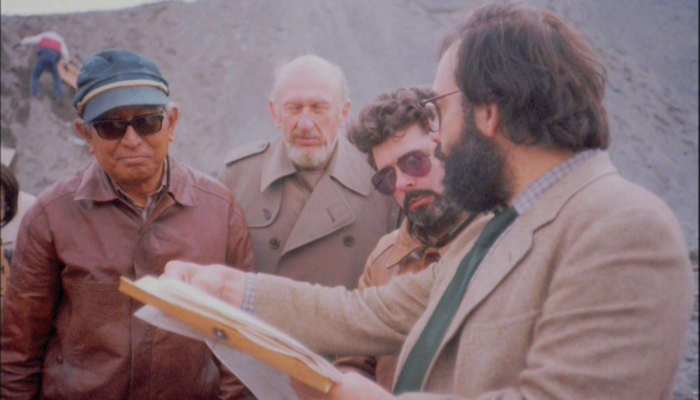
So how was it that George Lucas and Francis Ford Coppola became executive producers/presenters of a Japanese period epic? By being film nerds. Of course Lucas had famously taken inspiration from THE HIDDEN FORTRESS and other Kurosawa films. Coppola was also a fan, and had been able to meet Kurosawa, who had been having trouble getting funding for a personal film since being replaced on TORA! TORA! TORA!. The two Americans thought it was shameful that one of the great living masters couldn’t even get a movie funded, so they set about to use their clout to make it happen. The Japanese studio Toho wouldn’t give Kurosawa as much as he needed for KAGEMUSHA, so Lucas (still hot shit from STAR WARS) asked Fox to complete the funding in exchange for international rights. They didn’t figure it was gonna make them money, but they did it as a favor to him.
Check out the bonus disc of the Criterion Edition for a nice featurette of Lucas and Coppola discussing their involvement and feelings on the movie. They both seem proud to have made it happen while not seeming to rank the movie high among Kurosawa’s work. Coppola seems hung up on the fact that ZATOICHI’s Shintaro Katsu had originally been cast as the thief, but was replaced by Tatsuya Nakadai (YOJIMBO, SANJURO) after Katsu offended Kurosawa. Coppola felt Katsu had an unpredictability that would’ve fit the character better and made him more fun. He might be right.
Like what happens with some of the Weinstein movies now (THE GRANDMASTER being an extreme example), the international version of KAGEMUSHA was shortened from 180 minutes to 162. As if somebody who’s already willing to see a 2 hour and 42 minute subtitled period piece is gonna be too intimidated if it’s 3 hours. Despite this you gotta give Fox credit. Not only would the movie not have existed without their money, but it was unusual in those days for a Japanese film to play for American audiences at all. They made it possible for film buffs outside of Japan to see a new Kurosawa film on the big screen.
Of course Lucas and Coppola did not have the audacity to tell Kurosawa what to do. They just used it as a learning experience, and opportunity to visit the set (and in the case of Coppola, co-star with Kurosawa in some Suntori Whisky commercials which are included on the Criterion DVD). In that Criterion interview Lucas describes nerding out watching how Kurosawa used his cameras during the battle sequences. He doesn’t mention it, but you can see in the picture above that he also brought Irvin Kershner (ON DEADLY GROUND), who was doing EMPIRE STRIKES BACK for him around the same time.
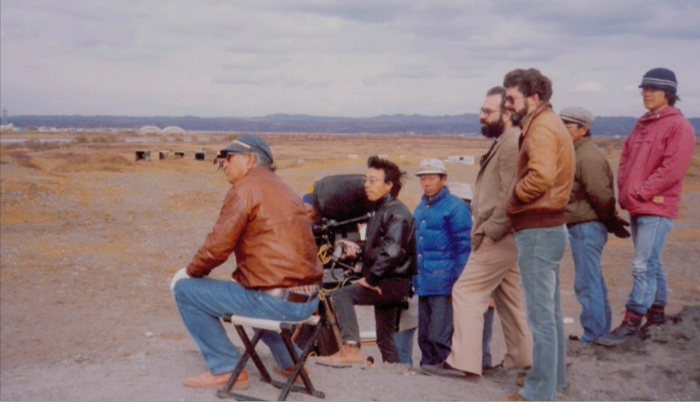
Lucas and Kershner may have taken some influence from KAGEMUSHA. Compare the dream sequence here to the scene in THE EMPIRE STRIKES BACK (which came out a few months before KAGEMUSHA but must’ve had some overlap in development and filming). Luke Skywalker has a vision of fighting Darth Vader only to discover his own face under the mask. Though visually very different, both are symbolic dreams with their hero facing some type of doppelganger attacking in slow-motion. Lucas would also build a few KAGEMUSHA-like elements into the world of the STAR WARS prequels. Like Lord Shingen, the Queen of Naboo is protected by lookalikes (in fact, one dies in her place when her ship gets bombed). And Naboo is also seen to be ruled by monarchs who are still children (though they’re said to be democratically elected).
Anyway, the takeaway here is that Lucas used his power to get Kurosawa behind the camera again and projected onto more screens than ever. That’s a good use of power.



























December 8th, 2015 at 12:50 pm
I really love Kurosawa, especially Seven Samurai, Rashomon, Ran and High and Low, but I have yet to successfully get through this movie. I’ve tried watching this three times, and for whatever reason that static five-minute shot at the start of the movie makes me turn it off, which makes me feel like a film hater or something. However, your review has encouraged me to give it another go. Great job as always.